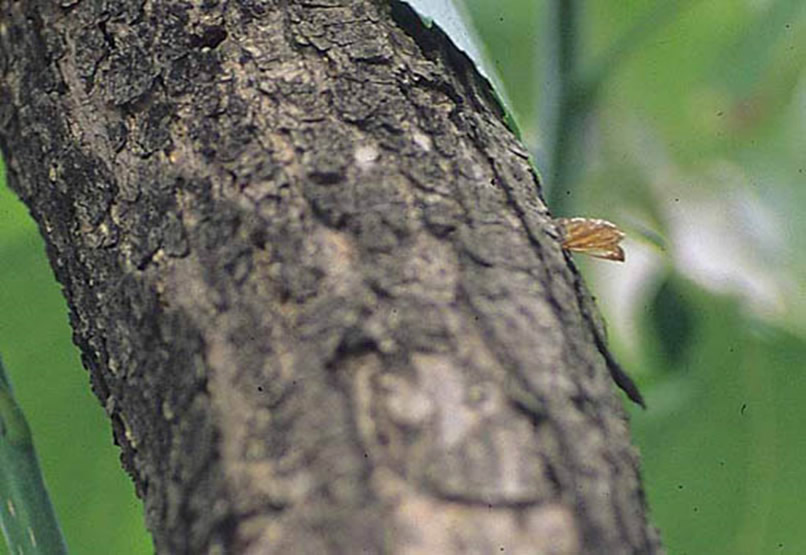Issue 2, May 7, 2019
Lilac / Ash Borer
Lilac borer (Podosesia syringae; also called ash borer) feed on lilac, ash, privet and other members of the olive family. Adult moths are about 1 inch long, slender, with dark brown bodies and yellow banding. They resemble paper wasps in appearance and behavior. They are active during the day and flex their abdomens as they walk.
Peak moth flight occurs in late May and early June depending on your location in Illinois. During this time, adults are mating and laying eggs. Adult females can live about a week, during which they can lay up to 400 oval, tan color eggs. Typically eggs are laid near cracks or wounds in tree bark.
Larvae hatch from the eggs within 14 days. The larvae are cream color with brown heads and can grow 1 to 1 ½ inches in length. Larvae chew into the tree where they tunnel and feed on the tree’s cambium. Eventually, these larvae will bore deeper into the tree, feeding on the sapwood and heartwood. This type of larval feeding disrupts water and nutrient transport in the trees leading to dieback.
When you are scouting for lilac borer, look for scaring or cracks near the base of plants. Key signs that lilac borer might be present are sawdust and sap accumulation near or below the site of boring, a ¼ inch hole. The sawdust piles up as larvae feed and push debris out of the holes they create. Sap can accumulate at the boring site in response to the borer wounding the tree.
Lilac borer larvae overwinter in the tunnels they chew into the tree. In the spring they pupate and the adult moths emerge from the tree, leaving their pupal casings behind. The pupal casing can sometimes be seen at the opening of the exit hole, which is another identifying sign for this species.

Lilac borer pupal casing protruding from an exit hole.
There are multiple ways to prevent lilac borer injury. The first is to focus on plant health. Because lilac borers are attracted to stressed plants, improving plant health through watering, fertilizing, mulching and avoiding damage during maintenance can help prevent future issues by making the plants less attractive. Avoiding pruning when moths are present can also make plants less attractive to borers.
Lilac borers tend to attack lilac trunks that are greater than 2 inches in diameter. Cutting away trunks larger than 2 inches in diameter and encouraging sucker growth is a cultural control that can limit lilac borer damage.
Biological controls can be used to treat lilac borer larvae. Beneficial nematodes can be applied as a spray application or injected into larval tunnels where they will infect and kill lilac borer larvae.If you choose to treat an existing lilac borer using chemical controls, timing is the key to applying an effective treatment. Spray applications of permethrin (Astro) or chloranitroniliprole (Acelepryn) can be made on the surface of the tree bark when larvae are active. The timing can be determined in two ways:
- Monitor male moth populations to time your application. Pheromone traps can be used to monitor the male moth population. Check the traps 2 to 3 times per week and record the number of males. This will give you the ability to identify when you have peak male capture. This timing will coincide with peak egg-laying by female moths. By applying a treatment to the trunk 7 to 14 days after peak male capture, newly hatched larvae will be in contact with the insecticide before they bore into the tree.
- Applications can also be timed based on plant phenology. If the pest is present and causing damage, apply a treatment to the trunk at the end of bloom for common lilac (Syringa vulgaris).
It may be tempting to apply a systemic neonicotinoid treatment like imidicloprid (Merit) to the trees. However, neonicotinoid treatments are not effective in killing lilac borer larvae.
Author:
Sarah Hughson